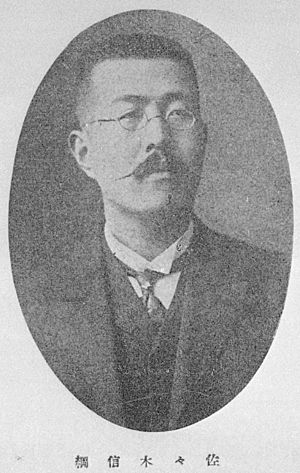Nobutsuna Sasaki facts for kids
Quick facts for kids
Nobutsuna Sasaki
|
|
|---|---|

Sasaki in the mid-1930s
|
|
| Native name |
佐佐木 信綱
|
| Born | 8 July 1872 Suzuka, Mie Prefecture, Japan |
| Died | 2 December 1963 (aged 91) Kamakura, Kanagawa, Japan |
| Resting place | Yanaka Cemetery, Tokyo |
| Occupation | Japanese poet and literary scholar |
| Language | Japanese |
| Alma mater | Tokyo Imperial University |
| Genre | tanka poetry |
| Literary movement | Chikuhakukai |
| Notable awards | Order of Culture (1937) |
Nobutsuna Sasaki (佐佐木 信綱, 8 July 1872 – 2 December 1963) was a famous Japanese poet and scholar. He was known for his tanka poetry and for studying old Japanese literature from the Nara period and Heian period. He was very active during Japan's Shōwa period.
Contents
Early Life and Education
Nobutsuna Sasaki was born in what is now Suzuka city, in Mie Prefecture. He was a very smart child, often called a "child prodigy." His father, Sasaki Hirotsuna, taught him how to write poetry. His father also encouraged him to learn many classic tanka poems by heart.
After finishing his studies at Tokyo Imperial University, Nobutsuna decided to follow his father's wishes. He chose to spend his life working with waka poetry. This meant he would both research old poems and write new ones himself.
A Career in Poetry and Scholarship
In 1894, Sasaki wrote a long poem called Shina seibatsu no Uta. This poem was about the start of the First Sino-Japanese War. It became very popular. One line from the poem compared falling cherry blossoms to Japanese soldiers bravely falling in battle. This idea became a well-known symbol in Japan until the end of World War II.
Founding a Literary Society
Sasaki started a group for writers called the Chikuhakukai. This name came from his father's pen-name (a special name a writer uses). In 1898, his group began publishing a magazine called Kokoro no Hana, which means "Flower of the Heart."
Through this magazine, Sasaki shared his ideas about waka poetry. He also published his research on how Japanese poetry had grown over time. The magazine helped him teach and inspire many new poets. Some of his famous students included Kawada Jun, Kinoshita Rigen, and Katayama Hiroko. Kokoro no Hana is still published today, making it Japan's oldest poetry magazine.
In 1902, Sasaki traveled to China. He explored the Yangtze River and visited cities like Hangzhou and Suzhou.
New Poetry and Important Research
Sasaki was part of a movement to change and improve tanka poetry. He worked with other famous poets like Masaoka Shiki and Yosano Tekkan. In 1903, he published his first collection of tanka poems called Omoigusa ("Grasses of Thoughts"). He later published eleven more collections, including Shingetsu ("New Moon," 1912) and Yama to mizu to ("Mountains and Water," 1951).
Because of his great work, Sasaki was asked to teach at Tokyo Imperial University in 1905. The Ministry of Education also asked him to write a modern guide to the Man'yōshū. The Man'yōshū is a very old and important collection of Japanese poems. Sasaki worked with his father on this project. In 1915, they published a detailed study of medieval waka called Wakashi no kenkyu ("Studies in Japanese Poetry").
Later, Sasaki led a team of scholars who created a special index for the Man'yōshū. This index, published from 1924 to 1925, is still used today by people who study the Man'yōshū.
Honors and Imperial Connections
In 1934, Sasaki became a member of the important Imperial Academy. In 1937, he was the first person ever to receive the Order of Culture from the Japanese government. He also joined the Japan Art Academy that same year.
Sasaki was later chosen to provide poetry to the Imperial Family. He also became a judge at the yearly Utakai Hajime poetry contests, where people read poems. He even taught Empress Teimei and other members of the imperial family how to write poetry.
Later Life and Legacy
In 1921, Sasaki moved from Tokyo to Kamakura, in Kanagawa Prefecture. He lived there until he passed away in 1963. He also had a home in Atami, Shizuoka, a town famous for its hot springs.
Nobutsuna Sasaki's grave is in the Yanaka Cemetery in Tokyo. After he died, a museum was built in Suzuka city, Mie prefecture, where his old home used to be. This museum holds some of his original writings. His summer home in Atami, Shizuoka, has also been kept safe by the local government.

